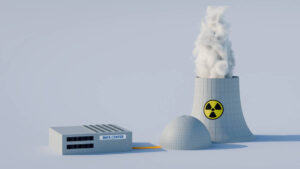Resource Connect Asia: Uranium changes from yellow to green ahead of supply shortage that could put rocket under prices

Picture: Getty Images
- Global uranium giant Cameco has grown increasingly bullish on uranium, which is emerging as an under-appreciated part of the energy transition
- Biden’s IRA is not just about lithium, with as much as US$30b of loan guarantees and incentives for the nuclear energy sector
- Explorers see interest flowing back into greenfields uranium plays
An executive at the Western world’s largest uranium company says the market is beginning to recognise nuclear energy as a green energy play in a flipping of the script ahead of a major supply shortage.
Cameco senior vice president and CFO Grant Isaac said at the Resource Connect Asia Future Facing Commodities Forum in Singapore this week we are at the start of a major contracting cycle with one of the largest nuclear reactor builds in decades — 57 reactors worldwide — about to hit.
And it could come like a tonne of bricks, given Cameco has just green lit the restart of the world’s biggest mine McArthur River and that can’t fill the supply deficit from the existing 450 reactors in service.
Prices have hovered around US$50/lb all year, around 3x above cyclical lows seen from 2016 to 2018, when Cameco previously placed the massive McArthur River complex in Saskatchewan on care and maintenance.
That is higher than the start point for previous contracting cycles, Isaac said, referring to the period when utilities look around and realise how short they are on uranium supplies.
“We’re seeing utilities begin to contract, but they’re not even at replacement rate yet so utilities around the planet are consuming more off old contracts than they’re coming in to replace,” Isaac said.
“That’s a pretty exciting situation because it means we’re in the early innings of one of our security of supply driven contracting cycles. The primary supply stack isn’t poised to respond. We don’t have those secondary volumes that have helped fill the gap in the past.
“We’ve never been at this stage of a cycle at a US$50 uranium price already.”
Isaac says higher prices are needed to encourage new sources of production to market, especially with Russia’s expulsion from eastern and central Europe seeing utilities traditionally reliant on the belligerent nation turn to Western companies like Cameco for supply.
“We need to see more contracting. It’s as simple as that. The resources are there,” Isaac said.
“The Reserve Base isn’t at today’s prices. It’s all suggestive of a very bright future for uranium.”
Clean energy
One thing uranium miners and explorers have been able to leverage is the energy transition.
While nuclear energy has a bad rap, its advantage in the shifting sands of global energy production is it is low in carbon emissions and unlike renewables does not require the support of battery storage or thermal switching to run 24-7.
Cameco’s partner in the acquisition last year of nuclear services firm Westinghouse was investment group Brookfield’s renewables arm, lending institutional credibility to uranium’s green credentials.
“One of the things we liked quite frankly, is Mark Carney and Brookfield Renewable taking nucular from the fringes of the clean energy debate, and dropping it right in the middle,” Isaac said.
“With a global investor base that had already plowed into their funds, they raised US$15 billion the first time, they’ve of course announced raising another US$20 billion for their second Clean Energy Transition Fund.
“We’ve talked forever and ever about the role that nucular needs to play in clean energy.
“But we’re in a nucular company, so people always took that with a grain of salt. When Brookfield Renewable said it belongs at the centre of a clean energy transition, that’s a different conversation.
“And it’s the investor reaction that’s actually out in front of policymakers right now, which gives us a sense that there’s a durability that maybe has escaped this industry in the past.”
IRA a boon for nuclear too
Much focus has been placed in recent times on the sometimes absurd sounding incentives the Biden Administration is willing to give to ensure lithium for electric vehicles is mined and processed in the United States and its partner countries, in a direct contest with Chinese investment.
“The Inflation Reduction Act in terms of nuclear I think is completely under appreciated,” Andre Liebenberg, the CEO of London-Listed physical uranium fund Yellowcake PLC told Stockhead on the sidelines in Singapore.
“There are direct credits to keep existing fleets alive, there are loan guarantees, there’s support in terms of new technologies.
“People talk about the impact on lithium, I think the impact on nuclear is massive.
“If I total up the numbers in terms of loan guarantees and ancillary benefits it could easily be US$30 billion, it’s huge.
“And now we see Europe looking to compete with the US on similar terms in terms of green.”
Liebenberg cites energy security concerns, with Russia’s major role in nuclear fuel production and traditional energy inspiring a move to secure Western energy supplies, including in uranium from places like Europe, Japan and Korea.
“How the West turns away from Russia is going to be really, really interesting,” Liebenberg said.
“The factors that were in play when we IPO’d in 2018 are in play today, but strengthened and the energy security and energy independence issues is a big issue that wasn’t around a couple of years back.”
$21 to $50
When Yellow Cake bought its first uranium in 2018 it paid just US$21/lb.
But Liebenberg says there is a long way to go.
“This is a supply side story,” he said.
“If you look at copper, you look at demand and you look at China.
“In this instance the demand is visible because it takes a long time to permit a plant and build a reactor.
“The issue here is supply. We haven’t seen any new mines being developed in the last five years, supply is depleting and demand is growing.
“So for me it’s a supply side story, where’s that supply going to come from? For the new marginal cost of production is probably US$75/lb and we’re sitting at US$51/lb so the price has to go up.
“And if you don’t get new supply the price is going to fly up because there’s going to be a shortage.”
Encouragement for explorers
Through the downturn, sparked by the Fukushima disaster in 2011 and the closure of Japan’s entire reactor fleet, exploration has gone out the window, with little to no motivation to develop new mines in the current pricing environment.
But early stage explorers and developers are now eyeing off far stronger conditions, with support returning from investors for greenfields plays.
GTI Energy (ASX:GTR) last week announced an inferred 1.66Mlb resource and combined 14.15-23.45Mlb exploration target at its Great Divide Basin projects in Wyoming in the USA, close to Ur-Energy’s operating Lost Creek in situ recovery facility.
“We’ve been the only ones for the last two years actively exploring in the Great Divide Basin,” executive director Bruce Lane told Stockhead.
“What we’re going to see now is in the next 12-18 months we’re going to see a resurgence of exploration in line with the increasing prices, it’s pretty straight forward.
“The uranium price contracted at US$60-65/lb is going to start to bring exploration dollars back into play.”
There are some established mines that represent the slack in the rope, mines that have large resource or idled production that can come back online quicker than greenfields projects, Lane said.
“But I think the exploration sector in general is only starting to come back to life and we’re one of the early companies in that space, certainly in Wyoming.”
Lane said prices are moving up to levels that could help companies like GTI.
It is chasing cheaper, lower capex in situ recovery uranium, a shallow, bore-field style of mining that accesses resources at just 100m below the ground, as opposed to the 500m-1000m deep resources in Canada’s higher grade Athabasca Basin.
Lane is hoping to outline around 10Mlb to justify a 1Mlb a year project targeting free cash generation of around US$30-35/lb in what he says are ‘back of the envelope’ numbers.
If Liebenberg and Isaac’s assessments are correct, GTI and other companies like could be helped by a fast-moving yellowcake market.
“The uranium might be US$60, might be US$65, who knows it may be US$80/lb by the time we get to contract,” he said.
GTI Energy (ASX:GTR) share price today:
At Stockhead, we tell it like it is. While GTI Energy is a Stockhead advertiser, it did not sponsor this article.

UNLOCK INSIGHTS
Discover the untold stories of emerging ASX stocks.
Daily news and expert analysis, it's free to subscribe.
By proceeding, you confirm you understand that we handle personal information in accordance with our Privacy Policy.








